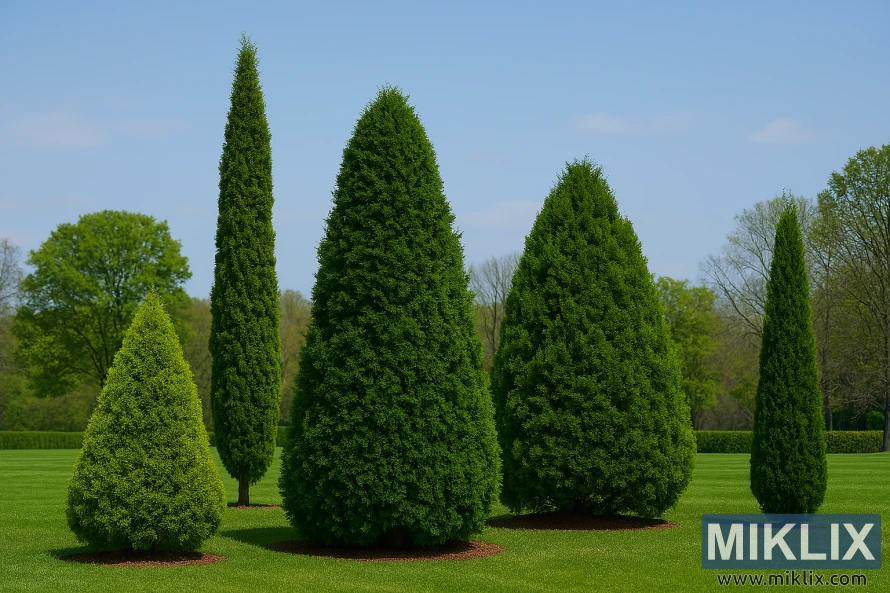Image: Side-by-Side Comparison of Arborvitae Varieties
Published: November 3, 2025 at 9:47:24 PM UTC
Explore a high-resolution image comparing different Arborvitae varieties, showcasing their relative sizes, shapes, and foliage textures in a landscaped setting
This high-resolution landscape image presents a curated visual comparison of five distinct Arborvitae (Thuja) cultivars, arranged side by side in a sunlit park setting. The composition is designed to highlight the relative sizes, shapes, and foliage textures of each variety, offering a clear and aesthetically pleasing reference for horticultural education, landscape planning, or nursery cataloging.
The trees are evenly spaced across a vibrant green lawn, each planted in a circular bed of reddish-brown mulch that contrasts with the grass and anchors the base of each specimen. The background features a soft blend of deciduous trees in full leaf, with a clear blue sky and wispy clouds overhead, providing a neutral and natural backdrop that enhances the clarity of the comparison.
From left to right:
Tree 1: A bright green conical Arborvitae with a broad base and sharply tapered apex. Its foliage is dense and finely textured, composed of tightly packed scale-like leaves. This cultivar likely represents a compact pyramidal form such as ‘Techny’ or ‘Nigra’, known for its robust structure and vibrant coloration.
Tree 2: The tallest and narrowest of the group, this columnar Arborvitae rises with a slender silhouette and uniform branching. Its foliage is a slightly darker green, and the vertical emphasis suggests a cultivar like ‘North Pole’ or ‘DeGroots Spire’, ideal for tight spaces and formal hedging.
Tree 3: Centered in the composition, this tree has a classic pyramidal shape with a broad base and gently rounded apex. Its foliage is rich and full, with a soft, velvety texture. The cultivar may be ‘Green Giant’, known for its fast growth and stately presence in large landscapes.
Tree 4: Slightly shorter and broader than the center tree, this specimen has a more pronounced taper and loosely arranged branches. Its foliage is a deep green with subtle tonal variation, suggesting a cultivar like ‘Smaragd’ (Emerald Green), prized for its refined form and consistent color.
Tree 5: The smallest and most slender of the group, this Arborvitae has a tight columnar form with compact, dark green foliage. Its upright habit and minimal spread suggest a juvenile ‘North Pole’ or similar narrow cultivar, often used for vertical accents or space-constrained plantings.
The composition is bathed in natural sunlight, which casts soft shadows and highlights the textures and contours of each tree. The even lighting and clear spatial arrangement allow for easy visual comparison of height, width, foliage density, and overall form.
This image serves as a practical and visually engaging reference for anyone seeking to understand the morphological diversity within the Arborvitae genus. It is especially useful for landscape designers, nursery professionals, and educators aiming to illustrate cultivar selection based on spatial needs, aesthetic preferences, or functional roles in garden design.
The image is related to: A Guide to the Best Arborvitae Varieties to Plant in Your Garden

